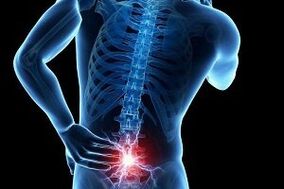
Osteoma is a disease of the spine that millions of people of all ages experience.
Degenerative and dystrophic changes of the intervertebral discs, proliferation of osteoblasts cause pain syndrome, decreased mobility of the supporting column. Symptoms depend on the affected area.
In most cases, the negative manifestations affect not only the support and vertebral region but also spread to other areas.
In the absence of treatment, the disease progresses, the work of organs and systems is disrupted, the state of health significantly worsens, constant pain and complications against the background of the pathology can lead toto disability.
It is important to know what osteonecrosis is, its common causes, treatment and prevention methods.
The reasons for the development of the disease
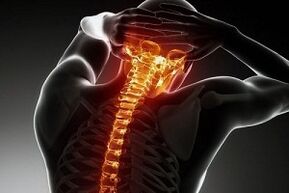
Degenerative and dystrophic processes in the intervertebral disc, excessive chemotaxis in the affected area develops in the following cases:
- back injury;
- high loads on support posts during heavy work, professional sports, carrying;
- congenital defects of the pole;
- vitamin and mineral deficiencies, reducing the quality of the buffer;
- violation of mineral metabolism;
- endocrine disorders, endocrine diseases;
- sedentary, sedentary;
- severe obesity;
- a decrease in the elasticity of the discs in the elderly, along with the aging of the body;
- excessive consumption of strong coffee, carbonated and alcoholic beverages, sour foods, smoked meats, smoking;
- Tumor process in the spinal region, causing damage to the elastic structures of the spine.
Types and stages
Osteochondrosis affects all parts of the support column. The degenerative process manifests itself more actively in the mobile regions: lumbar and cervical, in the thoracic region, vertebral lesions, bone tissue less often.
Depending on the affected area, there are several types of osteonecrosis:
- Cervical;
- chest;
- lumbosacral.
Stages of the disease:
- Early stage- the development of chondrosis. Lack of nutrients causes the quality of discs to deteriorate, and the elasticity of the foam cushions decreases. High loads on a background of thin cartilage tissue cause mild to moderate pain in the spine;
- second stage.The deformation of elastic structures is more pronounced, pain occurs not only when under load, but also when bending, turning. Failure of the fibrous ring leads to compression of sensitive structures, increased friction of bony elements;
- third stage.The integrity of the annulus is broken, the disc protrudes beyond the vertebrae, the pain syndrome is pronounced. It is difficult for the patient to perform without medication to relieve discomfort. Against the background of the destruction of the elastic cushion, the mobility of the support column decreases, protrusion and herniation of the disc develop;
- fourth stage.There is practically no cartilage layer, bone-forming cells appear on the spine. The bone growth is an attempt to offset the excessive load on the affected vertebrae. Dense elements stabilize the spine, but at the same time reduce the mobility of the problem area of the support column. In stage 4 of osteonecrosis, the pain gradually weakens but the patient finds it difficult to perform simple movements. If changes occur in the visual area, hemiplegia or lower hemiplegia may occur. Usually, in the fourth stage of osteonecrosis, the patient is disabled.
On a note!Disease of the spine occurs with periods of remission (from a few months to a year or more) and exacerbations (time to relapse, severity of pain depends on many factors).
First signs and symptoms
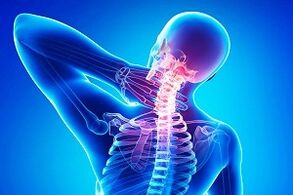
Manifestations of the disease depend on the stage and the part affected.
The more negative factors, the higher the risk of pain syndrome, damage to other areas.
Poor blood circulation, impaired mineral metabolism, protrusion of the eyes, development of vertebral hernia, excessive chemical presence in the affected area.
Self-medication, lack of qualified support, combined with the reluctance to visit a chiropractor periodically, negatively affect the state of the vertebral structure.
Cervical
The main signs are:
- lens syndrome with severe disc damage;
- pain in the back of the neck, neck, top;
- dizziness, fainting;
- headache;
- discomfort in the muscles of the shoulders, neck;
- numbness in the neck, hands, fingers;
- discomfort in the chest area;
- impaired mobility of the cervical spine;
- decrease or loss of reflexes of the shoulder muscles;
- "goose bumps" sensation in the hands, fingers;
- with osteonecrosis of the cervical spine, a person is tormented by insomnia, depression, irritability against the background of severe pain or aches in the neck and head.
Bone necrosis in the chest
Typical signs:
- with long periods of time in one position, carrying heavy loads, turning, bending over, chest pain occurs;
- with a deep breath, feeling of discomfort of varying degrees in the middle part of the back;
- when raising the arm, moving the body, the pain increases;
- with the progression of osteonecrosis of the thoracic region, problems appear in the work of the gastrointestinal tract;
- in the hand there is an unpleasant "goosebumps" feeling;
- Depending on the extent of the injury, the doctor distinguishes between low back pain - uncomfortable pain in the injured spine area and low back pain - acute, intense pain with high intensity, restricting breathing, causingmuscle spasticity;
- intercostal neuralgia develops;
- acute soreness or pain in the shoulder blade area;
- Reproductive disorders occur.
Lumbosacral region

The main symptoms are:
- discomfort of varying intensity in the lower back;
- muscle weakness, development of paralysis;
- cold and numbness of the lower extremities;
- pronounced pain syndrome when carrying heavy or lifting objects;
- the appearance of low back pain in the lumbar region: the pain spreads from the waist down to the buttocks, groin, legs;
- intermittent development;
- compression of the nerves adversely affects the work of the pelvic organs: with severe degree there may be bone necrosis, urinary incontinence, bowel incontinence;
- appeared fatigue, difficulty walking, walking for a long time, causing weakness in the legs.
Diagnose
To clarify the condition of the spine, you need to contact a chiropractor. In the absence of a doctor of this specialty, you need to see a neurologist or orthopedist.
Diagnostic measures:
- Examining patients, checking complaints.
- Magnetic resonance imaging.
- CT.
- X-rays of the spine in several projections.
- Doppler ultrasound of blood vessels.
- Electromechanical.
Effective treatments
How to treat osteonecrosis? Chronic illness requires the attention of both the physician and the patient. Do not expect that negative symptoms will disappear a week after starting the course of treatment. Only an integrated approach will yield results. Patients must understand that medication alone cannot eliminate degenerative-dystrophic changes in the intervertebral disc, blocking the proliferation of bone-forming cells.
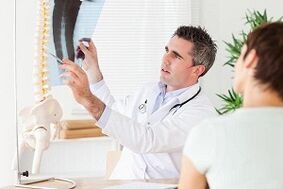
To successfully treat and prevent osteonecrosis, it is important to:
- perform a complex exercise therapy;
- participate in massage and physical therapy;
- Healthy food;
- organize the workplace and sleep, taking into account the recommendations of the doctor;
- do not lift weights;
- periodically supplement with vitamins, mineral complexes to maintain the elasticity of the discs, the strength of bone tissue;
- refuse exercises that are too intense;
- avoid back injuries and bruises;
- track your weight.
There are other important rules:
- do not overcool;
- treatment of pathologies that adversely affect the condition of the intervertebral discs;
- take breaks, warm up when working at the computer;
- move more, exercise;
- give up excessive coffee and alcohol consumption, forget about smoking;
- avoid prolonged static/dynamic loads;
- sleep on orthopedic mattresses and low pillows;
- do not worry;
- spend at least 7 hours for a night's sleep;
- periodically visit a vertebral specialist, monitor the condition of the vertebral structures.
Medicine
Effective groups and names:
- chondroprotectors. . . They restore cartilage tissue, slow down the destruction of discs. Course - 4 months or more;
- NSAIDs. . . The drug relieves pain, eliminates swelling and inflammation. Topical remedies for a good effect: ointments, lubricating gels;
- B group vitamins. . . The drug restores nerve regulation, improves the nutrition of nerve cells and reduces the intensity of pain syndrome. Injections (first days, during an exacerbation) and pills (for a long course of treatment and prevention) are effective;
- muscle relaxant. . . Means of dealing with muscle spasms, which are the main cause of compression of nerve endings;
- preparations that help to normalize blood circulation.Usually, drugs of this group are prescribed for cervical osteochondrosis, which the brain suffers from;
- spinal obstruction, injected into the spinal region. This type of exposure helps to relieve low back pain and severe pain against the background of pinched nerves in the third or fourth stage of osteonecrosis. Corticosteroids and excipients are added to analgesics to increase the effect;
- drugs belonging to the GCS class.Steroid formulations are essential for severe pain. Usually, injections are prescribed to treat glowing osteonecrosis, against which low back pain develops.
Exercise and gymnastics
Exercises for the cervical, abdominal and thoracic regions are indicated after acute pain relief, reducing the inflammatory process. For each area, the doctors developed a complex exercise therapy with different levels of stress.
The first sessions are conducted under the guidance of a physiotherapist. After studying the complex, the patient continues to practice at home. It is important to adhere to the timing and frequency of treatment sessions to achieve a therapeutic effect. In addition to physical education, chiropractors recommend going to the swimming pool: swimming is an ideal form that has a positive effect on the spine.
Physiotherapy procedures
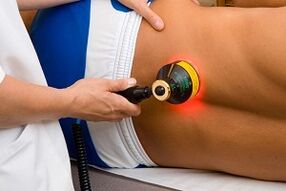
Effective methods of influence:
- ozokerite application;
- laser therapy;
- radon and turpentine baths;
- shock wave therapy;
- electrical procedures;
- mud therapy;
- electrophoresis and drug electrophoresis;
- acupuncture therapy.
The following methods are effective in treating osteonecrosis:
- Acupuncture;
- hirudotherapy;
- Acupressure;
- using needles;
- manual therapy;
- dry and underwater traction of the spine;
- medical iplikator.
It is quite difficult to prevent the development of osteonecrosis, but doctors recommend remembering the factors that cause degenerative and dystrophic processes in the vertebral structure. The more attention a person pays to a healthy lifestyle, the lower the risk of developing negative changes in the discs.

















































